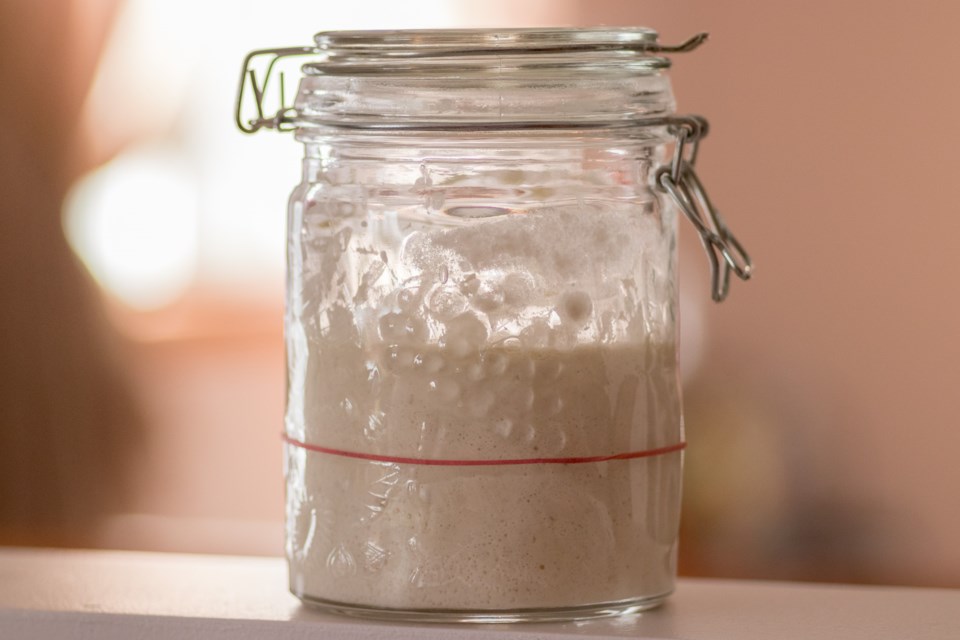Sourdough apparently is the oldest form of leavened bread made throughout history. All sourdough recipes begin with a starter consisting of flour, water and a small amount of sugar that has gone through a fermentation period. If cared for properly, a starter can last and produce for many years.
Starters were generally passed through families and between friends. There are many tales about how sourdough starter was kept alive. It's hard to surmise at what point it began but it was definitely born of necessity and likely more in terms of availability. There is no doubt sourdough bread-making is a labour of love.
James Smedley, a photographer and writer, has managed to carry on a family tradition passed down to him many years ago. He was kind enough to share his bread recipe with us and has inspired me to make my own starter.
"The first starter I used many years ago was from my uncle John Lash who claimed that his grandmother had brought it over from Scotland on the boats and kept it warm under her skirt. This was not true but we like to believe the story," said Smedley. "That was probably about 30 years ago that I used that starter and managed to keep it alive for many years. I only recently got back into making sourdough bread after a friend and neighbour in town, Bev Charbonneau, gave me some of her starter. Since then, her starter died and I was able to give her some of mine, then mine died and she was able to give me back some of hers. So between us, we have kept it alive for about a year."
Sometimes he makes bread once a week and other times he goes months without making a loaf.
"The starter is in a container in the cupboard and I feed it flour, water and a bit of sugar every four or five days to keep it alive. When I get too much starter, I often decide to make bread or sourdough pancakes. If you let the starter die you have to start from scratch. But normally I just use half the starter for bread and add flour and water and sugar," he said.
"I've been making bread for at least 30 years off and on. Over the last 10 years, I have been suffering from tendinitis and undergone a few operations so I didn't make a lot of bread, but I am now starting to get back into it. The particular recipe I shared is a very basic lighter loaf. Often I will add more multigrain and oatmeal and less white flour for a bit more of a hearty loaf. I generally bake for 36 minutes at 325°," Smedley told us.
Born and raised in Sault Ste. Marie but living in Wawa since 1988, isolation measures have not been too drastic for him as far as work goes.
"I have always worked alone in my basement office. However, now there is not as much work, my wife Francine is recently retired so it hasn't affected her with regard to work. Socially, however, we miss our friends and family. We do some stuff on social media and talk on the telephone, but of course, it's not the same. We are, however, very fortunate in comparison to other families because we can get outdoors and still do some of the things we love without coming in contact with others," said Smedley.
Bread-making is one of those indoor things that James and his family clearly appreciate. Jokingly he says, "When I take the bread out of the oven, I like to stand on one leg. It doesn't do anything but makes it look like I have some sort of secret ritual, haha."
There is a lot of information out there about getting started. I myself chose a Facebook group called Start Your Own Sourdough Starter Challenge! which I found to be very thorough, welcoming and informative. There are educational posts every day for each step in addition to recipes and ideas for use. Certainly, most of us have more time during the isolation and we are doing more cooking and baking than we have had time for in the past. Sourdough-making is one of those things that requires time, a commitment and a little bit of work. Supplies are generally minimal but the rewards are plenty.
Sourdough Bread Recipe
3 cups of white flour
1 cup water
1/4 cup of Red River cereal or some other multigrain mix
teaspoon of salt
tablespoon of sugar
tablespoon of oil
3/4 cup sourdough starter
Mix all ingredients together and knead into one big loaf or two small loaves.
Leave dough to rise for at least six hours covered with a clean tea towel and placed in a sunny area or near a heat outlet. Sometimes Sourdough is very slow to rise and it is necessary to leave it to rise overnight for baking in the morning. It should at least double in size.
Bake for 36 minutes (may differ a bit depending on situation) at 325°.
Eat.



